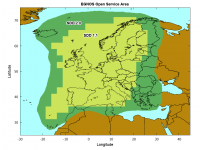If you wish to contribute or participate in the discussions about articles you are invited to contact the Editor
EGNOS Open Service
| EGNOS | |
|---|---|
| Title | EGNOS Open Service |
| Edited by | GMV |
| Level | Basic |
| Year of Publication | 2011 |
The EGNOS Open Service consists of a set of signals for timing and positioning intended for general purpose applications. It is fully accessible by means of a GPS/SBAS compatible receiver, it is free of charge and it does not require any receiver specific certification nor authorization.
Introduction
The EGNOS Open Service is fully operational and the signal-in-space is available since October 2009 for any user equipped with an EGNOS enabled receiver without any further requirement. Details about the EGNOS-enabled receiver design specifications can be found in EGNOS Receiver Specification document.[1]
This service is provided through the GEO satellites within the EGNOS service area and it improves GPS performances in Europe. However, EGNOS OS shall only be used for non safety critical purposes, i.e. those where degraded performances could not provoke personal damage. Besides, no service guarantee or liability is provided by the EGNOS Service provider,[2] the European Commission[3] or the European Space Agency (ESA).[4]
The EGNOS Open Service is the first EGNOS service to become available and its main objective is to obtain enhanced positioning accuracy by correcting the error contributions that affect GPS signals, which are related to satellite clocks, satellite payload induced signal distortion, satellite position uncertainties and ionospheric delays whereas other effects, such as tropospheric delays, multipath or user receiver contributions, are local effects and cannot be corrected by an SBAS system.
The EGNOS OS Definition Document states that the service is accessible in Europe to any user equipped with an appropriate GPS/SBAS compatible receiver for which no specific receiver certification is required.[5]
The OS was declared available on the 1st October 2009[6] and this EGNOS service is intended to be provided for a minimum period of 20 years with a 6 years in advance notice in case of significant changes in the Services provided.
Performance requirements
EGNOS performances are considered from a user perspective and they are expressed in terms of availability, continuity, integrity and accuracy. The minimum requirements for these terms are defined by SBAS standards which were conceived for civil aviation applications. These standards are called SBAS Minimum Operational Performance Standards and are published by RTCA under the reference DO-229.[5][7]
Consequently, MOPS intends to support aviation use and provides a series of features to guarantee integrity which, as expressed in EGNOS Service Definition Document,[5] may result in degraded performance over what could be reached if implementing a tailored processing of EGNOS signals for OS, due to the stringent aviation requirements.
In any case, all SBAS receivers expected to support OS shall:[5]
- Use the Geostationary satellite ranging function if available (broadcast through message types 9 and 17, this function is currently not supported by EGNOS). Two operational GEO`s: Inmarsat 3F2 (PRN 120) y SES-5 (PRN 136) and one Test/Back-up: Inmarsat-4F2.
- Decode and apply satellite clock corrections (broadcast through message types 2-5 and corresponding to satellites selected by message type 1).
- Decode and apply satellite ephemeris corrections (broadcast through message types 24- 25).
- Decode and apply ionospheric corrections (broadcast through message type 26 for ionospheric grid points selected by message type 18).
- Take into account major warnings sent through the SBAS messages (broadcast through message types 2-5 and 6).
Additionally, an OS receiver may use the content of message type 12, if used for time determination.
In order to define OS user performances, a number of assumptions are made:
- The user receiver shall implement MOPS DO-229 navigation weighted solution.
- The EGNOS receiver shall take into account the monitoring of satellites and Ionospheric Grid Points according to the UDRE/GIVE indicators processed.
- A clear sky environment is assumed with no obstacles masking satellite visibility greater than 5° above the local horizontal plane.
The minimum level of performance against which the system has been designed, as well as data of actual performance, is provided in the table and map bellow.[5] This data is solely presented for transparency in order to enable the user to make an informed decision regarding EGNOS OS use and, thus, actual EGNOS OS performance may differ in the future.
| Definition | Value | |
|---|---|---|
| Horizontal Accuracy | Corresponds to a 95% confidence bound of the bi-dimensional position error in the horizontal local plane for the worst user location. | 3 m |
| Vertical Accuracy | Corresponds to a 95% confidence bound of the uni-dimensional unsigned position error in the local vertical axis for the worst user location. | 4 m |
Limitations
The minimum performance levels stated in Section Performance Requirements are fulfilled in the vast majority of cases and service availability is also provided. However, there might be some situations where non nominal navigation performances are obtained. The most common causes of abnormal EGNOS behavior and their impact on performances are listed in the following table:[5]
| Cause of Service Degradation | Impact on OS User |
|---|---|
| Broadcasting delays:Acquisition of all SBAS parameters make take up to 5 minutes. | EGNOS Service is not available until a few minutes after receiver connection. |
| Signal attenuation: Adverse weather conditions and indoor environments weaken signals and may provoke loss of lock or degraded performance. | Degraded Position accuracy |
| EGNOS Signal Blockage: For users in high latitudes geostationary satellites may fall bellow the visibility mask whereas in urban environments the EGNOS signal could be lost for a period of time. | Performance degradation after a period of time: EGNOS will cope with temporary signal blockages but corrections will not be valid after a certain period. |
| Local Multipath: Signals suffer reflections on nearby objects causing local errors on the measurements. | Degraded position accuracy, specially on static or slowly moving users. |
| Signal Interference: Transmissions on adjacent frequency bands may interfere GPS and EGNOS signals. | It may result in accuracy degradation or total navigation loss depending on the intensity of the interference. |
| Ionospheric Scintillation: Ionospheric disturbances due to the solar activity can lead to severe signal degradation. | Satellite monitoring and the Navigation solution will be degraded. |
| Receiver Design: Before the certification of EGNOS for civil aviation, EGNOS used to transmit message MT0 with the contents of a regular MT2 which could be processed by a non-SoL receiver. | The removal of MT0 upon certification of the EGNOS Safety of Life Service, could cause the OS to be denied or a suboptimal performance obtained depending on the receiver manufacturer and configuration used. |
Credits
The information provided in this article has been compiled by GMV. In some cases, tables and paragraphs have been extracted from the indicated references, in particular from the EGNOS OS Definition Document.[5]
Notes
References
- ^ EGNOS Receiver specifications
- ^ ESSP Web Site
- ^ European Commission EGNOS Portal
- ^ European Space Agency EGNOS Portal
- ^ a b c d e f g EGNOS Open Service Definition Document
- ^ ESSP Archived news
- ^ Minimum Operational Performance Standards for Global Positioning System/Wide Area Augmentation System Airbone Equipment



